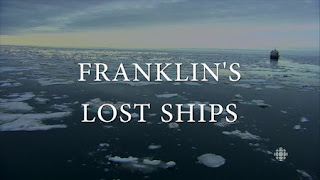 |
| Anne Keenleyside, Margaret Bertulli, and Barry Ranford (w. camera), 1993 |
Beattie's report offered only a very rough chart of where these remains were found, without specific geographical co-ordinates, which makes it hard to say whether in fact some of the key sites were identified then, or at a later time. That said, two men whose work shaped all that came after arrived on King William Island in the early 1990's: Dave Woodman, whose Unravelling the Franklin Mystery: Inuit Testimony (1991) was the first comprehensive analysis of the written record of oral testimony, and Barry Ranford -- an unlikely searcher who, until the Franklin bug bit had been a high-school art and photography teacher in a small town in Ontario.
Woodman, although he'd initially been unsure whether he could get the funding and support to test his claims, launched the first of his nine searches in 1992, this one using a magnetometer in an airplane to search the area west of Grant Point for traces of the anomaly he hoped one of the ships' engines would cause. That same year, Ranford and a former student of his searched the coast of King William, finding the bones -- notably a number of crania -- which Beattie apparently missed. He returned the next year with archaeologist Margaret Bertulli and forensic specialist Anne Keenleyside, who made the first proper archaeological study of a Franklin site. NgLj-2 -- the location of numerous bones with cut-marks, as well as NgLj-3 -- site of some crania, later identified by Keenleyside, Stenton, and Park as the location of a reburial made by Schwatka in 1871 -- were all mapped at that time.
And there to cover the find in 1994 was Carol Off of the CBC, along with cameraman Andrew Gregg (later to be the director of the 2014 documentary Franklin's Lost Ships). The resulting news feature, which included Margaret Atwood and Pierre Berton among its commentators, cemented the Franklin story in Canadian consciousness. Woodman -- who was back for his first on-the-ground serach, makes a cameo in the early program as well!
Sadly, Barry Ranford took his own life in 1996, but his friend (and former principal) John Harrington returned numerous times to continue the search. Woodman, too, came back again and again, along with his friend Tom Gross (who still continues searching to this day), trying every conceivable means to locate Franklin's ships, or any possible deposit on the shore, whether Franklin's grave or the famed 'vault' described to Hall by See-pung-ger. He scanned the stones in the summer, dragged a magnetometer on a sledge over the ice in the winter, and drilled down with an ice-augur to lower sonar booms. By his singular labors, a very large chunk of the "southern search area" -- that of the ship at "Ootjoolik" -- was covered.
In that same era, many other searchers -- among them George Hobson, Ernie Coleman, Cameron Treleaven (often accompanied by his friend Louie Kamookak), Wayne Davidson, Peter Wadhams, and Maria Pia Casarini -- trekked along these same shores, investigating mounds, cairns, and any other features of interest. Their searches were not all as persistent or methodical as Woodman's, but each of them found small, crucial pieces of evidence as to the fate of Franklin's men once they left the safety of their ships behind.
These searchers finally established a modern map of possibility -- even if, in one sense it was a negative map, that is, a map of where traces of Franklin were not. For in such a vast area, with such a small window of opportunity each year, such knowledge was vital all who came after; without it, the work of later investigators, such as the Parks Canada team, would have been far more daunting.
Photograph courtesy Margaret Bertulli







